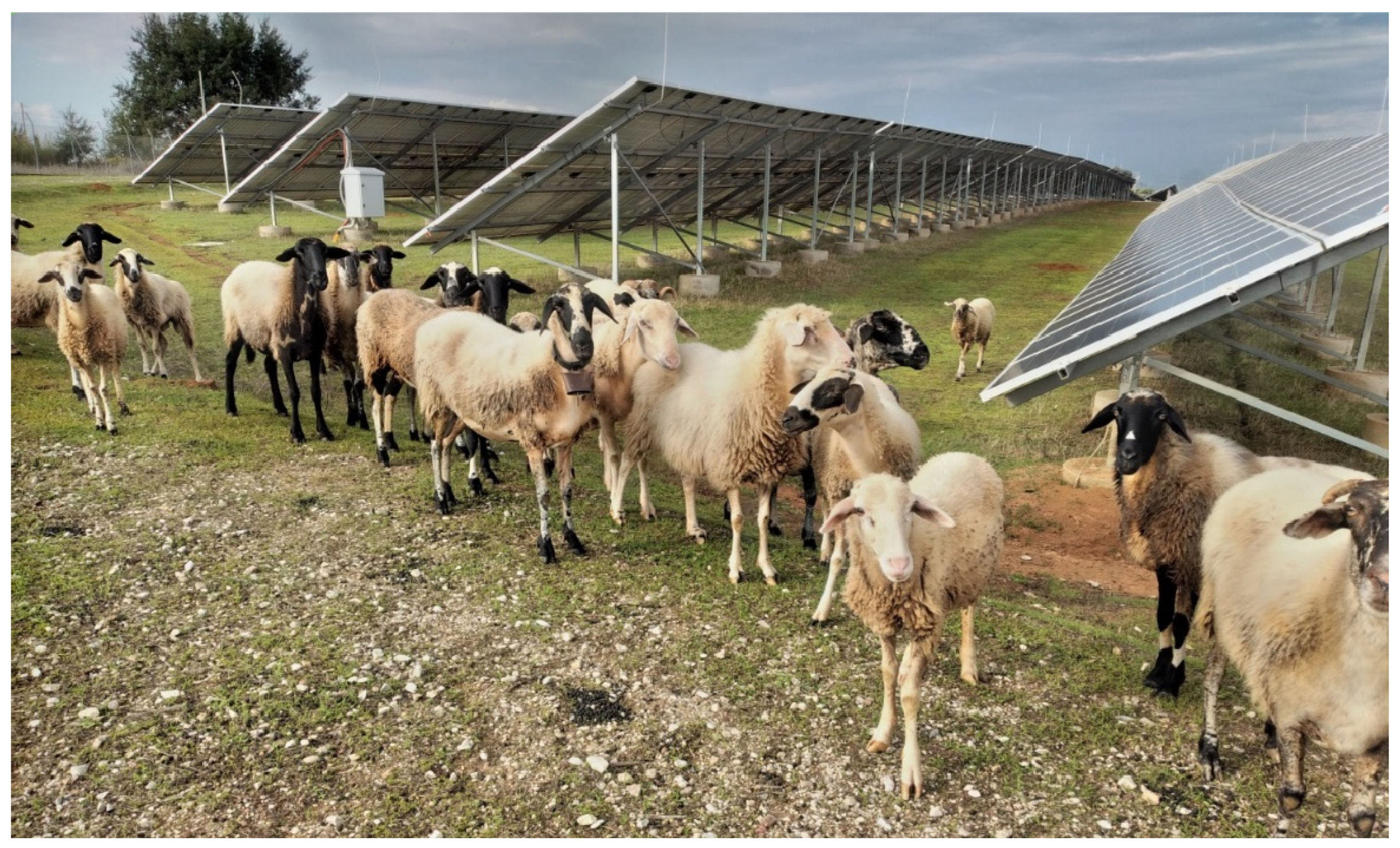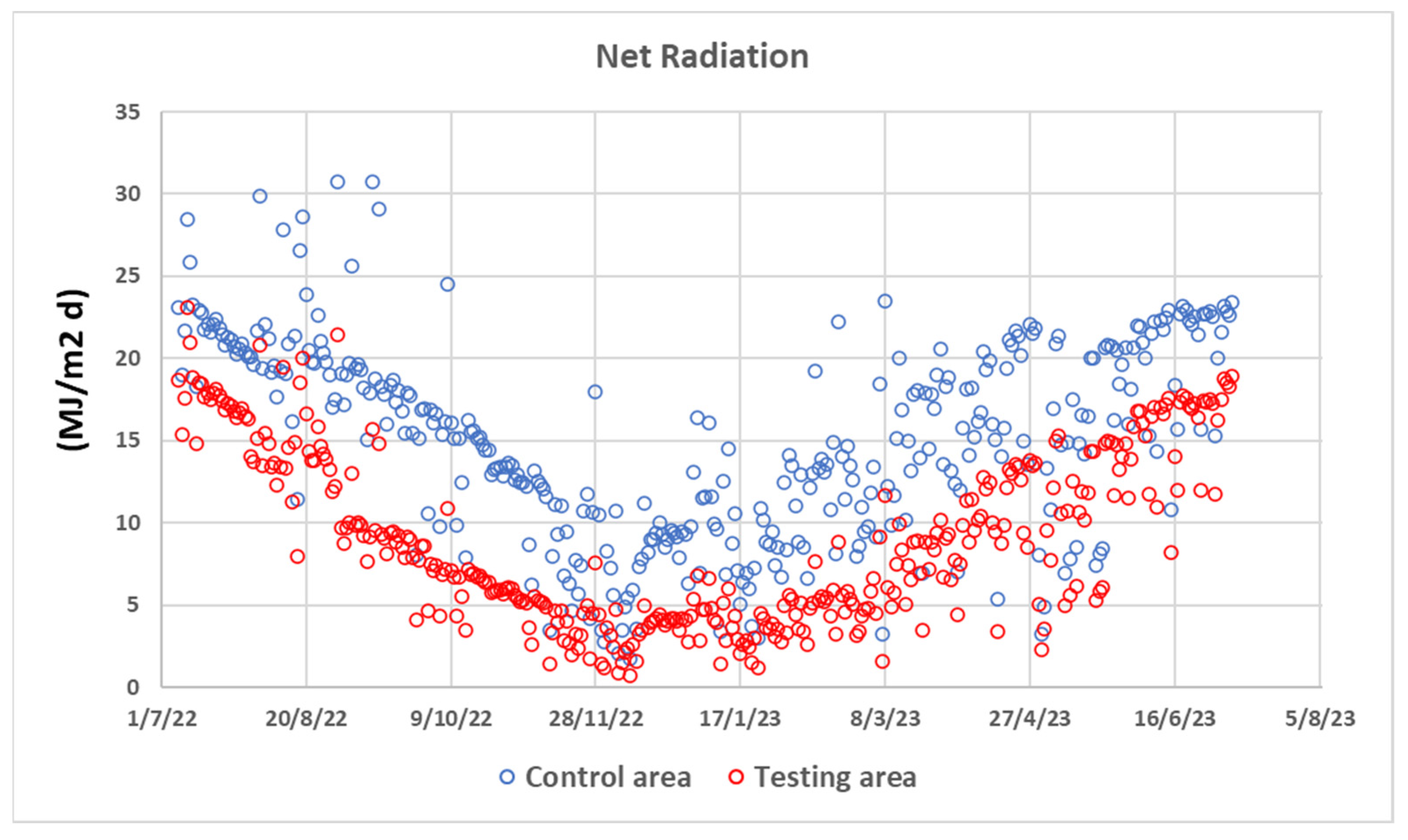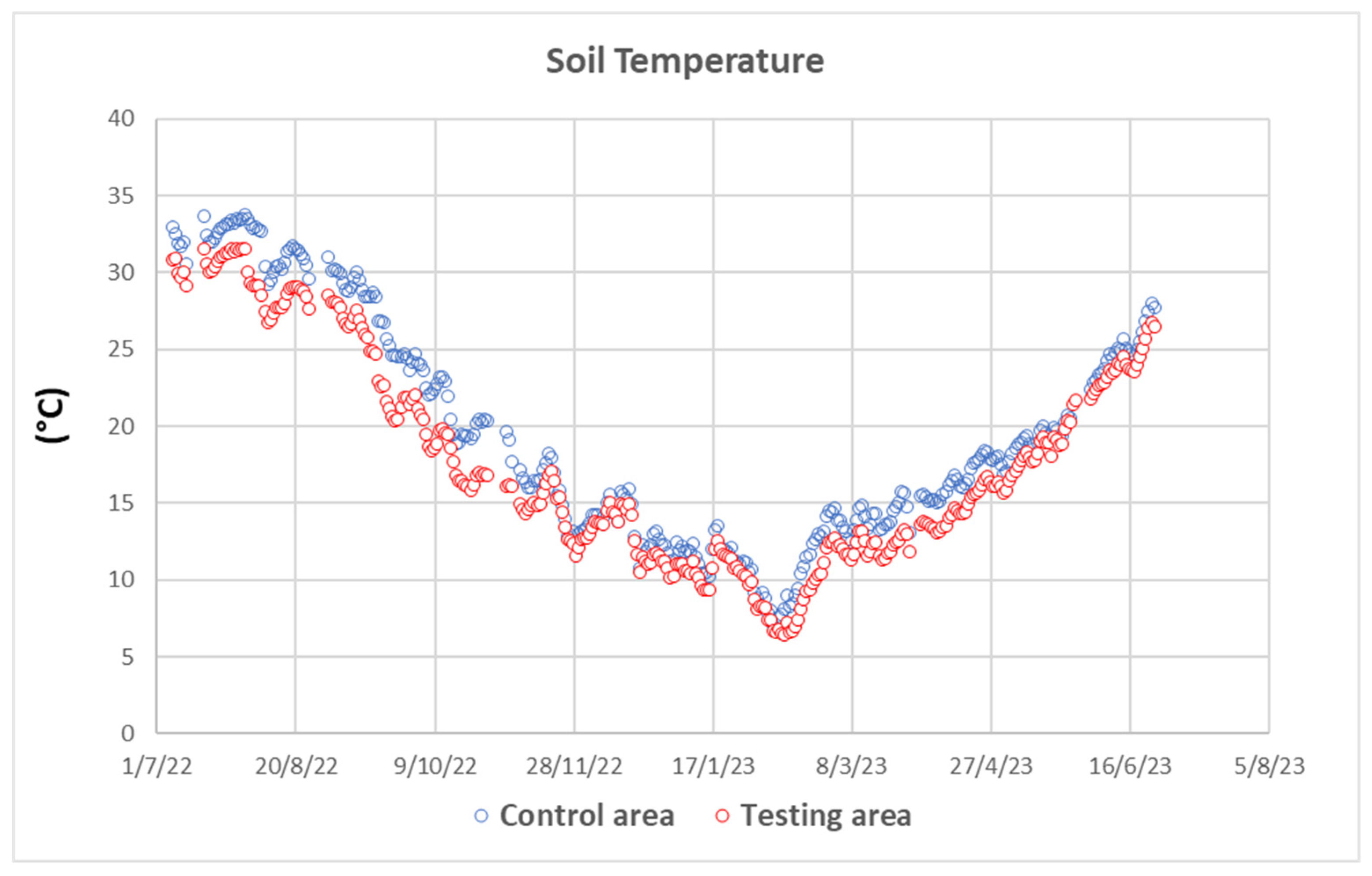Effects of a Photovoltaic Plant on Microclimate and Crops’ Growth in a Mediterranean Area
Abstract
1. Introduction
2. Materials and Methods
2.1. Site Features
2.2. Crops Selection
2.3. Microclimatic and Soil Data
2.4. Statistical Analysis
3. Results
3.1. Microclimatic Conditions
3.2. Soil Data
3.3. Plant Measurements
4. Discussion
5. Conclusions
Author Contributions
Funding
Data Availability Statement
Acknowledgments
Conflicts of Interest
References
- EU. Directive (EU) 2018/2001 of the European Parliament and of the Council of 11 December 2018 on the Promotion of the Use of Energy from Renewable Sources. 2018. Available online: https://eur-lex.europa.eu/eli/dir/2018/2001/oj (accessed on 1 September 2023).
- UNEP. Global Climate Litigation Report; Status Review: Nairobi, Kenya, 2023. [Google Scholar]
- IRENA. Renewable Capacity Statistics; International Renewable Energy Agency (IRENA): Abu Dhabi, United Arab Emirates, 2021. [Google Scholar]
- Dincer, I. Renewable energy and sustainable development a crucial review. Renew. Sustain. Energy Rev. 2000, 4, 157–175. [Google Scholar] [CrossRef]
- Nonhebel, S. Renewable energy and food supply: Will there be enough land? Renew. Sustain. Energy Rev. 2005, 9, 191–201. [Google Scholar] [CrossRef]
- van der Horst, D.; Vermeylen, S. Spatial scale and social impacts of biofuel production. Biomass Bioenergy 2011, 35, 2435–2443. [Google Scholar] [CrossRef]
- Vineesh, V.; Bhattacharya, J. Comparing hut-shaped-east-west array for fixed photovoltaic panels against conventional equator facing parallel rows for power output per unit field area. Energy Sustain. Dev. 2022, 70, 225–238. [Google Scholar] [CrossRef]
- Sacchelli, S.; Garegnani, G.; Geri, F.; Grilli, G.; Paletto, A.; Zambelli, P.; Ciolli, M.; Vettorato, D. Trade-off between photovoltaic systems installation and agricultural practices on arable lands: An environmental and socio-economic impact analysis for Italy. Land Use Policy 2016, 56, 90–96. [Google Scholar] [CrossRef]
- Dupraz, C.; Marrou, H.; Talbot, G.; Dufour, L.; Nogier, A.; Ferard, Y. Combining solar photovoltaic panels and food crops for optimizing land use: Towards new agrivoltaic schemes. Renew. Energy 2011, 36, 2725–2732. [Google Scholar] [CrossRef]
- Amaducci, S.; Yin, X.; Colauzzi, M. Agrivoltaic systems to optimize land use for electric energy production. Appl. Energy 2018, 220, 545–561. [Google Scholar] [CrossRef]
- GSE. Statistiche Trimestrali Sul Settore Fotovoltaico in Italia. 2022. Available online: https://www.expoclima.net/save-download/Documenti/5231 (accessed on 3 October 2023).
- Ong, S.; Campbell, C.; Denholm, P.; Margolis, R.; Heath, G. Land-Use Requirements for Solar Power Plants in the United States; Technical Report NREL/TP-6A20-56290; NREL: Denver, CO, USA, 2013.
- Goldberg, Z.A. Solar energy development on farmland, Three prevalent perspectives of conflict; synergy and compromise in the United States. Energy Res. Soc. Sci. 2023, 101, 103145. [Google Scholar] [CrossRef]
- Alsharif, W.; Saad, M.M.; Hirt, H. Desert microbes for boosting sustainable agriculture in extreme environments. Front. Microbiol. 2020, 11, 1666. [Google Scholar] [CrossRef]
- Touil, S.; Richa, A.; Fizir, M.; Bingwa, B. Shading effect of photovoltaic panels on horticulture crops production: A mini review. Rev. Environ. Sci. Biotechnol. 2021, 20, 281–296. [Google Scholar] [CrossRef]
- Marrou, H.; Dufour, L.; Wery, J. How does a shelter of solar panels influence water flows in a soil-crop system? Eur. J. Agron. 2013, 50, 38–51. [Google Scholar] [CrossRef]
- Weselek, A.; Ehmann, A.; Zikeli, S.; Lewandowski, I.; Schindele, S.; Högy, P. Agrophotovoltaic systems: Applications, challenges, and opportunities. A review. Agron. Sustain. Dev. 2019, 39, 35. [Google Scholar] [CrossRef]
- Hassanpour, A.E.; Selker, J.S.; Higgins, C.W. Remarkable agrivoltaic influence on soil moisture; micrometeorology and water-use efficiency. PLoS ONE 2018, 13, 0203256. [Google Scholar] [CrossRef] [PubMed]
- Yue, S.; Guo, M.; Zou, P.; Wu, W.; Zhou, X. Effects of photovoltaic panels on soil temperature and moisture in desert areas. Environ. Sci. Pollut. Res. 2021, 28, 17506–17518. [Google Scholar] [CrossRef] [PubMed]
- Wallace, J.S. Increasing agricultural water use efficiency to meet future food production. Agric. Ecosyst. Environ. 2000, 82, 105–119. [Google Scholar] [CrossRef]
- EGP. The Kourtesi Solar Farm: Greece 2011. Available online: https://www.enelgreenpower.com/our-projects/operating/kourtesi-solar-farm (accessed on 1 September 2023).
- Pulido-Mancebo, J.S.; López-Luque, R.; Fernández-Ahumada, L.M.; Ramírez-Faz, J.C.; Gómez-Uceda, F.J.; Varo-Martínez, M. Spatial Distribution Model of Solar Radiation for Agrivoltaic Land Use in Fixed PV Plants. Agronomy 2022, 12, 2799. [Google Scholar] [CrossRef]
- Allen, R.; Pereira, L.; Raes, D.; Smith, M. FAO Irrigation and Drainage Paper No. 56; Food and Agriculture Organization of the United Nations: Rome, Italy, 1998; pp. 26–40. [Google Scholar]
- Aschale, T.M.; Sciuto, G.; Pere, D.J.; Gullotta, A.; Cancelliere, A. Evaluation of Reference Evapotranspiration Estimation Methods for the Assessment of Hydrological Impacts of Photovoltaic Power Plants in Mediterranean Climates. Water 2022, 14, 2268. [Google Scholar] [CrossRef]
- Edouard, S.; Combes, D.; Van Iseghem, M.; Tin, M.N.W.; Escobar-Gutiérrez, A.J. Increasing land productivity with agriphotovoltaics: Application to an alfalfa field. Appl. Energy 2023, 329, 120207. [Google Scholar] [CrossRef]
- Barron-Gafford, G.A.; Pavao-Zuckerman, M.A.; Minor, R.L.; Sutter, L.F.; Barnett-Moreno, I.; Blackett, D.T.; Thompson, M.; Dimond, K.; Gerlak, A.K.; Nabhan, G.P.; et al. Agrivoltaics provide mutual benefits across the food–energy–water nexus in drylands. Nat. Sustain. 2019, 2, 848–855. [Google Scholar] [CrossRef]
- Hernández, V.; Cos, J.; Andrés, R.; Di Blasi, M.; Genovese, M.; Hellín, P.; Contreras, F.; Guevara, A.; Fenoll, J.; Flores, P. Impact of an agrivoltaic system on Aloe vera growth in a semi-arid climate. ISHS Acta Hortic. 2022, 1355. [Google Scholar] [CrossRef]
- Marrou, H.; Guilioni, L.; Dufour, L.; Dupraz, C.; Wery, J. Microclimate under agrivoltaic systems, is crop growth rate affected in the partial shade of solar panels? Agric. For. Meteorol. 2013, 177, 117–132. [Google Scholar] [CrossRef]
- Ferrara, G.; Boselli, M.; Palasciano, M.; Mazzeo, A. Effect of shading determined by photovoltaic panels installed above the vines on the performance of cv. Corvina (Vitis vinifera L.). Sci. Hort. 2023, 308, 311595. [Google Scholar] [CrossRef]
- Weselek, A.; Bauerle, A.; Hartung, J.; Zikeli, S.; Lewandowski, I.; Högy, P. Agrivoltaic system impacts on microclimate and yield of different crops within an organic crop rotation in a temperate climate. Agron. Sustain. Dev. 2021, 41, 59. [Google Scholar] [CrossRef]







| Site | pH 1:2.5 | E.C. 1:5 | Organic Carbon | N | C/N | P2O5 Assim. | K2O Exchang. | Clay | Silt | Sand | Texture |
|---|---|---|---|---|---|---|---|---|---|---|---|
| μS/cm | (%) | % | ppm | ppm | % | % | % | ||||
| CA | 7.05 | 117.0 | 0.94 | 0.12 | 7.9 | 75.0 | 158 | 19.0 | 14.5 | 66.5 | sandy loam |
| TA | 6.82 | 83.9 | 0.89 | 0.09 | 10.4 | 23.4 | 182 | 14.5 | 8.5 | 77.0 | sandy loam |
| Tmax | Tmin | Tmean | RHmax | RHmin | WS | |
|---|---|---|---|---|---|---|
| °C | °C | °C | % | % | m/s | |
| CA | 24.47 | 12.13 | 18.07 | 90.03 | 47.16 | 4.28 |
| TA | 24.68 | 12.32 | 18.05 | 89.88 | 51.73 | 2.63 |
| TA: CA ratio | 1.01 | 1.02 | 1.00 | 1.00 | 1.10 | 0.62 |
| Soil Water Potential (KPa) | Soil Temperature (°C) | |||
|---|---|---|---|---|
| Average | Average | Minimum | Maximum | |
| CA | −38.1 | 19.4 | 6.9 | 33.7 |
| TA | −25.1 | 17.7 | 6.4 | 31.7 |
| TA: CA ratio | 0.66 | 0.91 | 0.93 | 0.94 |
| CA | TA | ||||
|---|---|---|---|---|---|
| Average | St.dev. | Average | St.dev. | p (t) | |
| Thyme | |||||
| Height (cm) | 33.7 | 4.1 | 36.6 | 5.1 | 0.18 |
| Vegetation cover (%) | 90.5 | 1.1 | 89.4 | 0.7 | 0.02 |
| Fresh weight (g/plant) | 235.6 | 32.3 | 249.0 | 81.7 | 0.64 |
| Oregano | |||||
| Height (cm) | 50.6 | 6.8 | 55.4 | 9.4 | 0.21 |
| Vegetation cover (%) | 81.1 | 2.6 | 77.5 | 8.2 | 0.20 |
| Fresh weight (g/plant) | 215.0 | 32.8 | 283.3 | 70.1 | 0.01 |
| Greek mountain tea | |||||
| Height with flower (cm) | 37.9 | 5.7 | 36.0 | 7.7 | 0.54 |
| Vegetation cover (%) | 83.6 | 1.7 | 74.6 | 2.6 | 0.00 |
| Fresh weight (g/plant) | 62.5 | 32.8 | 91.7 | 40.7 | 0.09 |
Disclaimer/Publisher’s Note: The statements, opinions and data contained in all publications are solely those of the individual author(s) and contributor(s) and not of MDPI and/or the editor(s). MDPI and/or the editor(s) disclaim responsibility for any injury to people or property resulting from any ideas, methods, instructions or products referred to in the content. |
© 2024 by the authors. Licensee MDPI, Basel, Switzerland. This article is an open access article distributed under the terms and conditions of the Creative Commons Attribution (CC BY) license (https://creativecommons.org/licenses/by/4.0/).
Share and Cite
Fagnano, M.; Fiorentino, N.; Visconti, D.; Baldi, G.M.; Falce, M.; Acutis, M.; Genovese, M.; Di Blasi, M. Effects of a Photovoltaic Plant on Microclimate and Crops’ Growth in a Mediterranean Area. Agronomy 2024, 14, 466. https://doi.org/10.3390/agronomy14030466
Fagnano M, Fiorentino N, Visconti D, Baldi GM, Falce M, Acutis M, Genovese M, Di Blasi M. Effects of a Photovoltaic Plant on Microclimate and Crops’ Growth in a Mediterranean Area. Agronomy. 2024; 14(3):466. https://doi.org/10.3390/agronomy14030466
Chicago/Turabian StyleFagnano, Massimo, Nunzio Fiorentino, Donato Visconti, Gian Maria Baldi, Michele Falce, Marco Acutis, Maria Genovese, and Miriam Di Blasi. 2024. "Effects of a Photovoltaic Plant on Microclimate and Crops’ Growth in a Mediterranean Area" Agronomy 14, no. 3: 466. https://doi.org/10.3390/agronomy14030466
APA StyleFagnano, M., Fiorentino, N., Visconti, D., Baldi, G. M., Falce, M., Acutis, M., Genovese, M., & Di Blasi, M. (2024). Effects of a Photovoltaic Plant on Microclimate and Crops’ Growth in a Mediterranean Area. Agronomy, 14(3), 466. https://doi.org/10.3390/agronomy14030466









